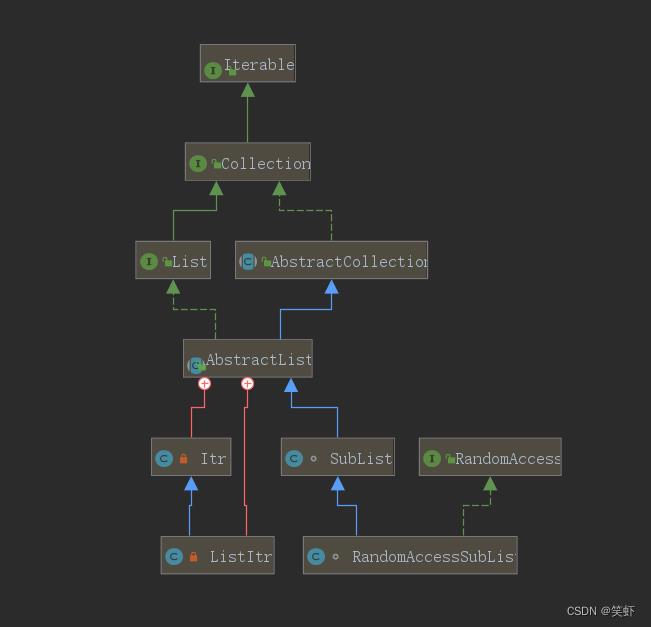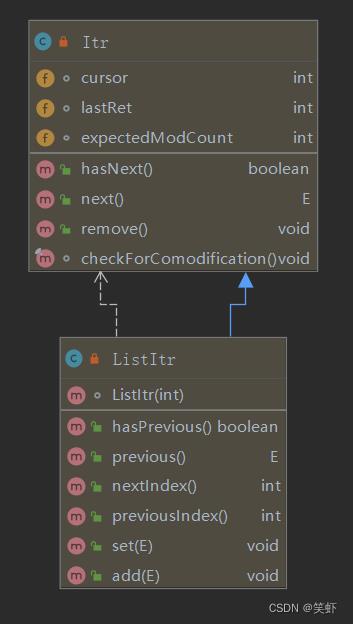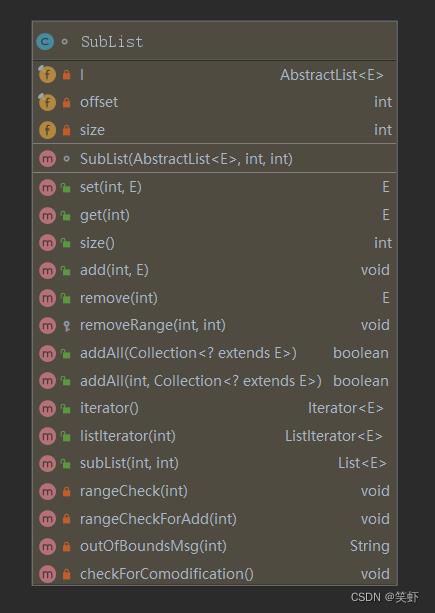Java 集合学习笔记:AbstractList
Posted 笑虾
tags:
篇首语:本文由小常识网(cha138.com)小编为大家整理,主要介绍了Java 集合学习笔记:AbstractList相关的知识,希望对你有一定的参考价值。
Java 集合学习笔记:AbstractList
- equals(Object o)
- hashCode()
- indexOf(Object o)
- lastIndexOf(Object o)
- clear()
- addAll(int index, Collection<? extends E> c)
- equals(Object o)
- Itr
- ListItr
- SubList
- 参考资料



equals(Object o)
实现 equals 对当前列表与指定对象 o 中的元素,按顺序两两对比。
- 元素数量要相等。
- 相同索引上的元素要满足:
o1.equals(o2) == true。
public boolean equals(Object o)
// 指定对象 o 与当前对象是同一个,直接返回 true
if (o == this)
return true;
// 指定对象 o 不是 List 的实现,直接返回 false
if (!(o instanceof List))
return false;
// 分别取出【当前列表】和【指定列表】的迭代器。
ListIterator<E> e1 = listIterator();
ListIterator<?> e2 = ((List<?>) o).listIterator();
// 按顺序成对逐个对比元素
// 如果两个列表都有 next 则都取出来,对比。
// 对 null 单独判断。
// 如果 o1 为 null 就判断 o2 是不是 null
// 如果 o1 非 null 就 o1.equals(o2)
while (e1.hasNext() && e2.hasNext())
E o1 = e1.next();
Object o2 = e2.next();
if (!(o1==null ? o2==null : o1.equals(o2)))
return false;
// 成对比较完成后,再检测是否有某个列表,还有更多的元素,一多一少,则不相等。
return !(e1.hasNext() || e2.hasNext());
hashCode()
可以看到这里的返回值是 int 出负数是没跑了
public int hashCode()
int hashCode = 1;
for (E e : this)
hashCode = 31*hashCode + (e==null ? 0 : e.hashCode());
return hashCode;
indexOf(Object o)
和大多数的处理逻辑一至,分为 null 和 非null 两个分支。
public int indexOf(Object o)
ListIterator<E> it = listIterator();
if (o==null)
while (it.hasNext())
if (it.next()==null)
return it.previousIndex();
else
while (it.hasNext())
if (o.equals(it.next()))
return it.previousIndex();
return -1;
lastIndexOf(Object o)
与 indexOf 相反,从后往前找。找到就返回索引。
public int lastIndexOf(Object o)
ListIterator<E> it = listIterator(size());
if (o==null)
while (it.hasPrevious())
if (it.previous()==null)
return it.nextIndex();
else
while (it.hasPrevious())
if (o.equals(it.previous()))
return it.nextIndex();
return -1;
clear()
调用 removeRange 将指定范围内的元素,逐个删除。
public void clear()
removeRange(0, size());
protected void removeRange(int fromIndex, int toIndex)
ListIterator<E> it = listIterator(fromIndex);
for (int i=0, n=toIndex-fromIndex; i<n; i++)
it.next();
it.remove();
addAll(int index, Collection<? extends E> c)
批量添加。
- 检查给定索引是否
index < 0 || index > size() - 这是修改标记
modified只能成功添加就会为true add方法等待子类实现。当前类中直接抛锅UnsupportedOperationException();
public boolean addAll(int index, Collection<? extends E> c)
rangeCheckForAdd(index);
boolean modified = false;
for (E e : c)
add(index++, e);
modified = true;
return modified;
equals(Object o)
public boolean equals(Object o)
// 给定对象 o 与当前对象 地址相同,则是同一对象,一定相等。
if (o == this)
return true;
// 如果给定对象 o 都不是 List 的实现,那肯定不相等。(因为我是)
if (!(o instanceof List))
return false;
// 取出当前列表和给定对象的迭代器。
ListIterator<E> e1 = listIterator();
ListIterator<?> e2 = ((List<?>) o).listIterator();
// 只要两个迭代器都有元素,就一直逐个对比
while (e1.hasNext() && e2.hasNext())
E o1 = e1.next();
Object o2 = e2.next();
// 如果我是 null 你也必须是 null (否则就不相等了)
// 如果我们都不是 null,调用 equals 对比。
if (!(o1==null ? o2==null : o1.equals(o2)))
return false;
// 上面都一对一对比过来了。无论谁还剩的有元素,那都说明我们不一样。
return !(e1.hasNext() || e2.hasNext());
Itr
private class Itr implements Iterator<E>
// 光标指向:下一个(要返回的)元素的索引。 int 类型默认值 0
int cursor = 0;
// 最近一次(返回的)元素的索引; 调用 remove 后会重置为-1,表示没有指向。
int lastRet = -1;
// 迭代器先记录下,列表的修改次数。后面做并发检测,如果两个值不相等,说明列表被别人动了。
// 如果是迭代器自己的修改操作 remove 它最后会同步两个数值。
int expectedModCount = modCount;
// 光标没指到
public boolean hasNext()
return cursor != size();
// 返回下一个元素
public E next()
checkForComodification();// 检查并发冲突
try
int i = cursor; // 拿到要返回的元素的索引
E next = get(i);// 获取元素
lastRet = i; // 更新 lastRet 指针(这东西是给 remove 用的)
cursor = i + 1; // 更新光标,指向下一次调next(要返回的)元素的索引
return next; // 返回元素
catch (IndexOutOfBoundsException e)
checkForComodification();
throw new NoSuchElementException();
// 移除上一次 next() 返回的元素
public void remove()
if (lastRet < 0) // 还没有调用过 next
throw new IllegalStateException();
checkForComodification(); // 检查并发冲突
try
// 调用 AbstractList 的 remove 方法删除元素(remove 需要子类来实现)
AbstractList.this.remove(lastRet);
// 删除元素后,其后元素整体左移一位 cursor 也要减一才对应的上。
if (lastRet < cursor)
cursor--;
lastRet = -1;
// 同步【迭代器】的修改计数和【列表】的修改计数。
expectedModCount = modCount;
catch (IndexOutOfBoundsException e)
throw new ConcurrentModificationException();
// 检查并发冲突
final void checkForComodification()
if (modCount != expectedModCount)
throw new ConcurrentModificationException();
ListItr
private class ListItr extends Itr implements ListIterator<E>
// 按给定索引值初始化对象
ListItr(int index)
cursor = index; // 初始当前位置
// cursor 不等于 0,表示前面还有元素。返回 true
public boolean hasPrevious()
return cursor != 0;
// 与 next 相反返回列表中的上一个元素。
public E previous()
checkForComodification(); // 检查并发冲突
try
int i = cursor - 1; // 取出前一个索引
E previous = get(i);// 获取前一个元素
lastRet = cursor = i;// 更新上次操作的元素的指针
return previous; // 返回前一个元素
catch (IndexOutOfBoundsException e)
checkForComodification();
throw new NoSuchElementException();
// next 将返回的元素的索引
public int nextIndex()
return cursor;
// 上一个元素的索引
public int previousIndex()
return cursor-1;
// 修改(索引 lastRet 所在的)元素
public void set(E e)
if (lastRet < 0)
throw new IllegalStateException();
checkForComodification();
try
// set 要让子类去实现
AbstractList.this.set(lastRet, e);
// 可能子类会修改列表,同步一下计数
expectedModCount = modCount;
catch (IndexOutOfBoundsException ex)
throw new ConcurrentModificationException();
// 当前位置插入元素
public void add(E e)
checkForComodification();
try
int i = cursor;
AbstractList.this.add(i, e);
lastRet = -1;
cursor = i + 1;
expectedModCount = modCount;
catch (IndexOutOfBoundsException ex)
throw new ConcurrentModificationException();
SubList
SubList 是对当前列表的片段引用。
class SubList<E> extends AbstractList<E>
private final AbstractList<E> l;
private final int offset;
private int size;
SubList(AbstractList<E> list, int fromIndex, int toIndex)
// 一通检测确保索引和size都正常
if (fromIndex < 0)
throw new IndexOutOfBoundsException("fromIndex = " + fromIndex);
if (toIndex > list.size())
throw new IndexOutOfBoundsException("toIndex = " + toIndex);
if (fromIndex > toIndex)
throw new IllegalArgumentException("fromIndex(" + fromIndex + ") > toIndex(" + toIndex + ")");
l = list; // subList 引用原列表
offset = fromIndex; // 开始索引
size = toIndex - fromIndex; // 算出subList应该有的大小
this.modCount = l.modCount; // 引用修改计数
// 调用原列表的 set,修改指定index所在的元素
public E set(int index, E element)
rangeCheck(index);
checkForComodification();
return l.set(index+offset, element);
// 调用原列表的 get
public E get(int index)
rangeCheck(index);
checkForComodification();
return l.get(index+offset);
public int size()
checkForComodification();
return size;
// 调用原列表的 add
public void add(int index, E element)
rangeCheckForAdd(index);
checkForComodification();
l.add(index+offset, element); // 因为实际调用的是原列表,所以要加上偏移量
this.modCount = l.modCount; // 同步计数
size++;
// 调用原列表的 remove
public E remove(int index)
rangeCheck(index);
checkForComodification();
E result = l.remove(index+offset); // 因为实际调用的是原列表,所以要加上偏移量
this.modCount = l.modCount; // 同步计数
size--; // 删除成功自然要更新 size
return result; // 返回被删除的元素(与原列表行为保持一至)
// 调用原列表的 removeRange
protected void removeRange(int fromIndex, int toIndex)
checkForComodification();
l.removeRange(fromIndex+offset, toIndex+offset);
this.modCount = l.modCount;
size -= (toIndex-fromIndex);
public boolean addAll(Collection<? extends E> c)
return addAll(size, c);
// 调用原列表的 addAll
public boolean addAll(int index, Collection<? extends E> c)
rangeCheckForAdd(index);
int cSize = c.size();
if (cSize==0)
return false;
checkForComodification();
l.addAll(offset+index, c);
this.modCount = l.modCount;
size += cSize;
return true;
// 返回迭代器
public Iterator<E> iterator()
return listIterator();
public ListIterator<E> listIterator(final int index)
checkForComodification();
rangeCheckForAdd(index);
return new ListIterator<E>() Java 集合学习笔记:ArrayList